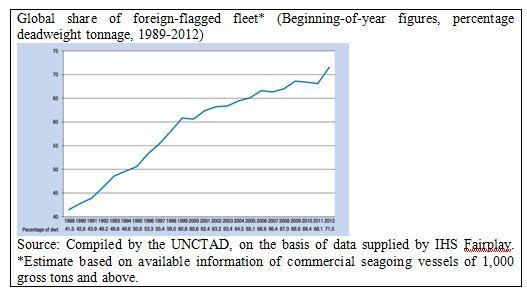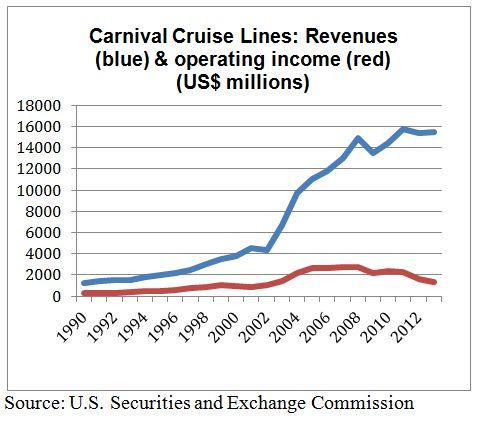Cruise Ships and Global Capitalism: The Industry’s Shifting Political Economy
archive

Cruise Ships and Global Capitalism: The Industry’s Shifting Political Economy
Millions of people have come to connect in different ways with the globalizing cruise industry, from passengers to employees, from locals at its various destinations to managers and owners. The industry has grown tremendously in recent decades, earning massive profits for its major stockholders. Yet whereas some social groups have benefited, others have been disadvantaged or sidelined by the industry’s changing structures. Like many other sectors of global tourism, the cruise ship industry has become adept at repatriating more and more value from passenger spending, while at the same time maintaining a web of local and regional alliances and relations that benefit from the industry. As Robinson explains: “The major portion of tourist earnings is captured by transnational capital without entering the host country to begin with, going to the TNCs that control air travel and the tour operators and travel agents that organize and coordinate the global tourist traffic.”1 The major companies in the cruise industry have come to embody what it means to be ‘transnational’—circumventing national borders and manipulating local economies in order to enrich the very few and sell “exotic” experiences to privileged sectors while at the same time generating very little benefit for those they exploit to achieve these ends. Below I delve briefly into several fundamental changes that have taken place in the industry in the epoch of global capitalism.

1. A variety of organizational and technological advancements have been used to streamline and heighten the exploitation of labor. The most important of these has been ‘flags of convenience’, a practice that allows companies to flag their ships from countries other than the location of ownership.
This allows for lower registration fees, tax dodging, and heightened freedom to employ cheap labor. Traditionally (during and before the 1960s and ‘70s), cruise ships were part of a national line (Greek Line, Italian Line, Cunard Line, etc.) that was flagged in that country. Most if not all workers were from that country. With the advent of flags of convenience in the 1970s and ‘80s coinciding with the growth of companies such as Carnival, company owners could use labor from wherever they wanted and increasingly avoid labor laws and environmental regulations. A number of small developing countries, with little to no enforcement measures, provide flags to ships around the world. Clearly the national and supranational laws enabling this practice ushered in changes to labor practices, which some labor organizations and civil society groups such as the International Transport workers Federation (ITF) in their campaign against flags of convenience and the ITF and War on Want’s 2002 ‘Sweatships’ campaign, have attempted to challenge. However, as the data below shows, the share of foreign-flagged (or ‘flag of convenience’) ships has expanded massively in recent decades.

2. Another change has been the development of much larger cruise ships. Large ships in the 1970s weighed 20,000 to 30,000 tons, while by the first decade of the 21st century they reached 220,000 tons. This has provided further impetus to the creation of new port facilities able to accommodate the larger ships. Larger ship capacities (from less than 1,000 passengers in the 1970s to more than 6,000 in the 2000s)2 also mean that fewer vessels are required for the same number of tourists.
3. Cruise ship companies have also gained unprecedented rights and powers. To attract TNCs active in global tourism, state officials in regions such as the Caribbean have lowered taxes and regulations and allowed the industry to operate relatively unhindered. Cruise ship tourism thus has come to provide only minimal tax income to states.3 This transition in the industry’s relationship with states is accompanied by a move away from traditional ports and state-run local port authorities. Nowadays, cruise companies are no longer at the mercy of local authorities and can more easily capture passenger spending at manufactured tourist sites, spending that in the past would have often been more directly connected with the local economy. The structure of new company-owned ports or enclaves in older ports (with fences and gates) also keep passengers inside “the port,” only leaving on company-controlled bus tours or with approved taxi companies. According to an expert in the field, this is very different from twenty or thirty years ago when cruise ship passengers had far less controlled experiences.4
4. A growing number of subcontractors, local shore excursion providers, and taxi companies competing for business have allowed cruise lines to maximize their profits by squeezing local economies. Competition between subcontractors and companies working in the tourist industry helps contain costs for the cruise lines. Importantly, subcontractors and small businesses that link into the industry and depend on it economically have also become important for advocating on behalf of the cruise industry, with tour excursion providers and taxi operators, for example, mobilizing to lobby on the industry’s behalf.

5. Cruise ship companies have further entwined with global capital flows through IPOs and partnerships with venture capitalists. Leon Black (Apollo Management) established Prestige Cruise Holding, which controls NCL, Regent Seven Seas, and Oceania; Carnival went public in 1987 by offering 20% of its stock; Royal Caribbean went public in 1993. This, alongside major technological and organizational advancements, has allowed for tremendous growth in industry revenue (as the data below depicts): Royal Caribbean annual revenues of 3.4 billion USD in 2002 grew to nearly 7.7 billion in 2012; Carnival Cruise Lines revenues in 1990 were 1.25 billion and by 2013 had reached nearly 15.5 billion.
6. The industry and its major owners and managers have become increasingly transnationally oriented, seeking out profits and advantages around the world through a web of partners, subsidiaries, and financial transactions. For example, while the Cruise Royal Caribbean Company maintains its official corporate headquarters in Miami, it is officially incorporated in Liberia. While it has come to be geared toward upper and middle class clientele, it has investors, customers, and employees from around the world. According to Forbes, the company is valued at US$ 9.4 billion. Expanding to regions worldwide as the North American and Caribbean markets became saturated; the cruise industry has recently opened new markets in Asia (especially in China, Vietnam and Thailand), Australia and New Zealand, the Middle East (Dubai), and in parts of Africa. The industry’s expansion has occurred alongside its increasingly finely tuned public relations and ‘corporate responsibility’ strategies.
The major companies in the cruise industry have come to embody what it means to be ‘transnational’—circumventing national borders and manipulating local economies in order to enrich the very few and sell “exotic” experiences to privileged sectors while at the same time generating very little benefit for those they exploit to achieve these ends.
Cruise ship companies are part of a huge and expanding global industry, yet they are on an economically, socially, and environmentally unsustainable trajectory. The shifting social relations and productive activities that undergird the industry have meant exploitation and disadvantages for too many. The industry has become increasingly monopolized by a handful of larger companies, driving smaller competitors out of business or acquiring them. Meanwhile, labor in the industry has become more socially alienated with low waged workers (from a increasingly wide variety of nationalities) on board the vessels whose activities are more and more standardized, monitored, and micro-managed.5
1 Robinson 2003, p. 197
2 Most large ships have capacities of between 3,000 and 4,500 passengers.
3 A port of call is any port being visited by a ship, especially to load or unload cargo or passengers or take on supplies.
4 Ross Klein explains: “Passengers traditionally wandered around towns more than they do now. However, when they do and spend money, the cruise line still gets its cut (commission). As well, many of the stores in ports are owned by offshore entities that have cozy relationships with the cruise lines.” (Sprague 2013)
5 This article will be examined in more depth and in regard specifically to the Caribbean region in a forthcoming journal article by the auth
Coggins, Jr., Andrew Oscar (2014) “The globalization of the cruise industry: a tale of ships,” Worldwide Hospitality and Tourism Themes, Vol. 6, No. 2, p. 138-151.
Hjalager, Anne-Mette (2007) “Stages in the economic globalization of tourism,” Annals of Tourism Research. Vol. 34, No. 2, p. 437-457.
ITF (International Transport Workers’ Federation) (2006) “What are Flags of Convenience?” itfglobal.org, available online at: http://www.itfglobal.org/flags-convenience/sub-page.cfm.
Klein, Ross A. (2005) Cruise Ship Squeeze: The New Pirates of the Seven Seas(Gabriola, BC: New Society Publishers, 2005).
Peetz, David and Murray, Georgina (2012) “The financialization of global corporate ownership,” in Murray, Georgina and Scott, John, Eds., Financial Elites and Transnational Business: Who Rules the World?(London: Edward Elgar Publishing), p. 26-53.
Perucic, Doris (2007) “The impact of globalization on supply and demand in the cruise industry,” Tourism and Hospitality Management, Vol. 13, No. 3, p. 665-680.
Robinson, William I. (2003) Transnational conflicts: Central America, Social Change, and Globalization (London: Verso)
Rodrigue, Jean-Paul. (2013) The geography of transport systems. New York: Routledge.
Sprague, Jeb. (2013) E-mail from Ross Klein to the author.
War on Want and ITF. (2002) “Sweatships.” Available online at: http://www.waronwant.org/attachments/Sweatships.pdf.
Wood, Robert E (2004) “Cruise ships: deterritorialized destinations,” in Lumsdon, Les Mand Page, Stephen J, eds., Tourism and transport: Issues and Agenda for the New Millennium (Amsterdam: Elsevier B.V.) p. 133-146.



